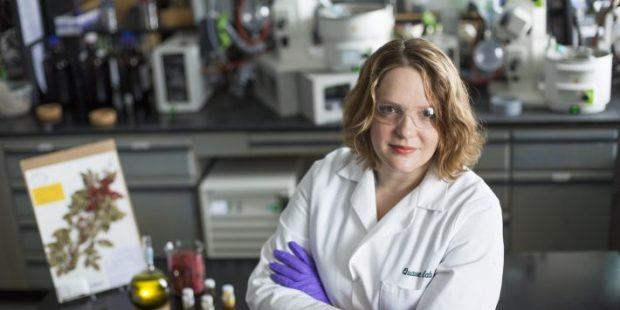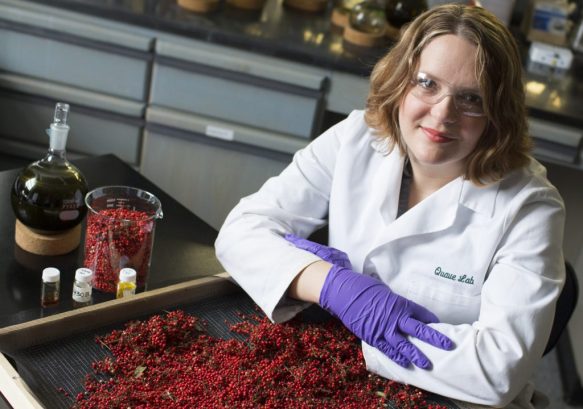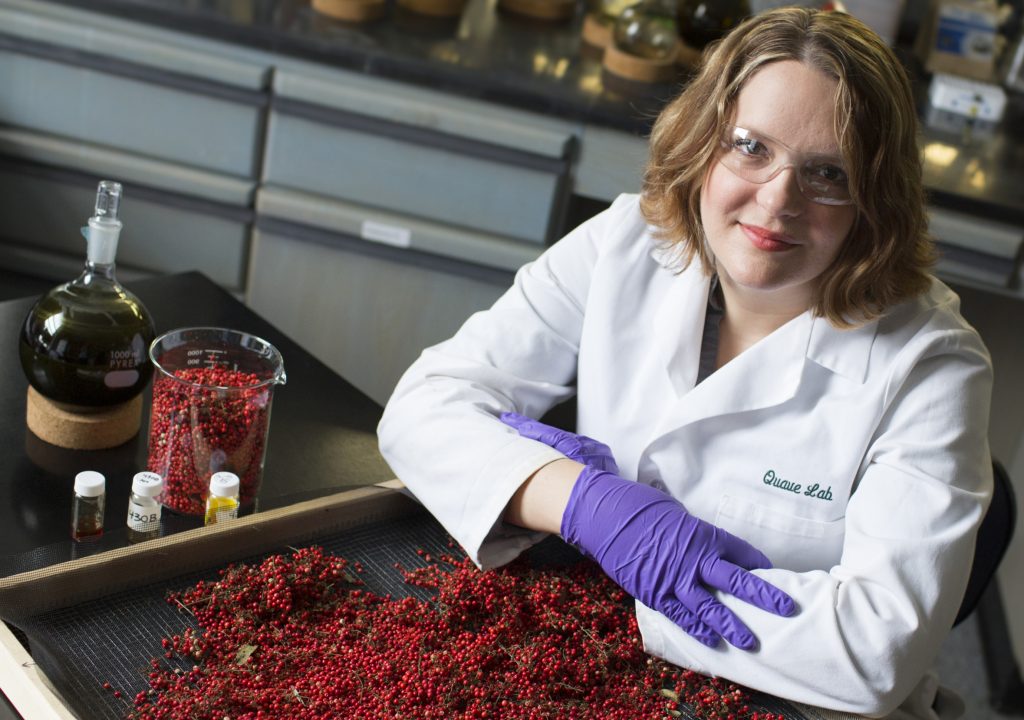This article was originally published by WABE.org
It’s bubbling, buzzing, humming and rattling in the small lab on the third floor of Emory University’s anthropology building. The room is packed with drying ovens, evaporators and centrifuges. Test tubes and petri dishes pile up behind glass windows. Researchers in lab coats scratch dark green powder out of mortar dishes.
This is where Cassandra Quave pursues a cure for infections, especially those that are resistant to common antibiotic treatments. But instead of developing more powerful antibiotics and joining a bacterial arms race, she revisits natural remedies that traditional healers have used for hundreds of years. Her work entails isolating, analyzing and testing the components in various formulations.
Quave is an ethnobotanist, a member of a small academic tribe located between biology and anthropology.
“This is a time for a paradigm shift,” says Quave, as she moves swiftly between the long lab tables, a cup of steaming coffee in one hand. Research, she says, cannot be confined to just one way to fight antibiotic resistance.

“We need to take multiple approaches from many different angles because more and more resistant organisms are emerging,” adds Quave, who’s also an assistant professor of dermatology and the curator of the herbarium at Emory.
Drug-resistant superbugs are one of the world’s most pressing public health concerns. Every year, 23,000 Americans die of anti-microbial-resistant infections, according to the CDC. Even reserve antibiotics — drugs of last resort — are becoming increasingly ineffective. The World Health Organization predicts that by 2050, 10 million people globally could die from multi-drug-resistant infections.
It’s a development that’s been long in the making, since bacteria always adjust to their environment in order to survive, says Michael Bell, deputy director of the division of health care quality promotion at the CDC.
“Our very clever ability to harness antibiotics over the last century is starting to run into challenges,” he adds.
“I’m often just sitting in the shade for hours, talking to old fishermen or old women about how they would procure wild plants to use as medicine or food,” Cassandra Quave says of her research field trips. (Courtesy of Emory University)
One of the most prominent survivors of a multi-drug-resistant infection is Georgia native Aimee Copeland.

Her story made national news in 2012, when the then-24-year-old University of West Georgia student cut her leg in a fall caused by a zip-lining accident. A few days later, she developed necrotizing fasciitis, better known as flesh-eating disease, a bacterial infection that does not respond to standard antibiotics. Copeland survived but lost her left leg, her right foot and both hands.
It may be decades before patients like Copeland can benefit from alternative approaches to treat infections, but research to replace or complement antibiotics is in full swing.
This includes studying the anti-infectious properties of plant compounds, like the leaves of the chestnut tree or the bright red berries of the Brazilian peppertree, both remedies that Quave has worked on extensively.
Some early findings
Last year, Quave, along with other scientists, published the results of a small but promising study.
Quave’s team had infected lab mice with a severe multi-drug-resistant bacterial infection. They then applied peppertree extract onto the animals’ skin. The treatment prevented the mice from developing skin lesions.
“We found that instead of killing pathogens, the peppertree compound shuts down their ability to sense one another,” says Quave. “So, we basically take away their weaponry.”
Bacteria, Quave explains, use signal pathways to communicate, so they can team up and jointly produce and release toxins.
As the compounds from the peppertree extract disable the signals, the bacteria remain isolated.
The root of the elm leaf blackberry is another powerful plant from Quave’s collection. It consists of about 500 specimens and 1,200 extracts to date.
“Instead of blocking the bacteria’s offensive tools, these compounds disrupt the bacteria’s defensive mechanism,” says Quave. They turn off the bacteria’s ability to form a slimy, soggy, sugary layer of protein, called biofilm.
“And that makes the bacteria more vulnerable, not only to the immune system but also to antibiotic therapies that are given to the patient,” according to Quave.
She knows the enemy firsthand
The fight against drug-resistant bacteria is personal for Quave.
Born in the small South Florida town of Arcadia, she had a childhood that was less idyllic than the name might suggest. She had multiple congenital birth defects to her skeletal system, missing several bones in her right leg and foot. When she was 3, her leg was amputated below the knee to improve mobility. After surgery, she developed a life-threatening staph infection, which led to many more surgeries.
“I had my dance with death,” she says with a weary shrug.
Today, Quave is 39, married to a fellow researcher and the mother of three kids, 12, 10, and 4. The family sometimes joins her on field trips to South America, Italy and the Balkans, where she studies and gathers plants.

“I’m often just sitting in the shade for hours, talking to old fishermen or old women about how they would procure wild plants to use as medicine or food,” she says.
That’s how she learned about the healing powers of peppertree berries and elm leaf blackberry roots, as well as other plants like wormwood, the fig tree and St. John’s wort.
“Those aren’t old wives’ tales,” Quave insists. “I don’t think that people are using the same remedies over and over for centuries, passing it down from generation to generation, unless there’s some form of human efficacy.”
But it is still too soon to introduce the extracts in clinical practice, says Quave. “We still have a lot of work to do in terms of formulation.”
Traditionally, most plant remedies are applied to the skin. But Quave thinks pills, drops or an IV may also be options.
CDC expert Bell seconds Quave’s call for caution in experimenting with the extracts.
“With every drug, antibiotic and otherwise, there’s always a trade-off between improvement and toxicity,” he says.
Quave’s work has arrived at a critical point. She and her team must launch a set of pre-clinical trials to get the research from the lab to the clinic and on track for approval by the Food and Drug Administration.
“It is very difficult to get funding at this point,” she says. This particular stage of research is known among scientists as the valley of death. “The place where drugs go to die,” Quave adds with a dry smile.
But Quave knows her way around in the valley of death, and the thought of giving up would never cross her mind.
“I hope that in my lifetime, we can make some contribution toward improving the way we are treating infectious diseases in the future,” she says.
Katja Ridderbusch is an Atlanta-based independent journalist who contributes to German and American newspapers, magazines and public radio stations. She frequently reports about health care in the United States.

